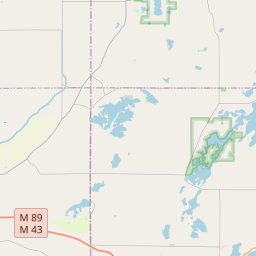Early History of Martin
Historical marker location:
Martin, Michigan
( Marker is at the intersection of 10th Street and Templeton Street, on the right when traveling north on 10th Street.)







© OpenStreetMap contributors
Martin was First Settled a Year Before Michigan Became a State
Loading...
Searching for other points of interest within 3 miles of this location.Michigan is the only state to have two designated "state stones": the Petoskey Stone, which is the state stone of Michigan, and the Isle Royale Greenstone, which is the state gemstone of Michigan. The Petoskey Stone is a fossilized coral that is found primarily in the northern Lower Peninsula, while the Isle Royale Greenstone is a rare mineral found only on Isle Royale in Lake Superior.
About Allegan County
Allegan County Timeline
Allegan County, located in the southwestern region of Michigan, has a rich history that dates back to the 1600s. Prior to European settlement, the area was inhabited by Native American tribes, including the Potawatomi and Ottawa, who utilized the land for hunting, fishing, and agriculture. In the early 19th century, European settlers began to arrive, attracted by the fertile soil and abundant natural resources.
The county's official establishment took place in 1831 when it was separated from the larger Kalamazoo County. The name "Allegan" is derived from the Native American word "Allegawaho," which means "lake land." The county seat was initially located in Allegan Village, but it was later moved to the town of Allegan in 1838.
One of the prominent industries in Allegan County's early years was lumbering. The area's vast forests provided an ample supply of timber, which was harvested and processed for various uses. The lumber industry helped fuel economic growth, attracting settlers and facilitating the establishment of towns and communities.
In the late 19th and early 20th centuries, agriculture became a significant economic driver in Allegan County. The fertile soil and favorable climate allowed for the cultivation of various crops, including corn, wheat, fruit orchards, and dairy farming. The county's agricultural industry continues to thrive today, contributing to its reputation as a vital agricultural region in Michigan.
Over the years, Allegan County has grown and developed, expanding its infrastructure and diversifying its economy. Today, it offers a mix of rural and urban areas, picturesque natural landscapes, recreational opportunities, and a strong sense of community. The county's rich history is celebrated through various local historical sites, museums, and events, providing a glimpse into its past while embracing the opportunities of the present.
The county's official establishment took place in 1831 when it was separated from the larger Kalamazoo County. The name "Allegan" is derived from the Native American word "Allegawaho," which means "lake land." The county seat was initially located in Allegan Village, but it was later moved to the town of Allegan in 1838.
One of the prominent industries in Allegan County's early years was lumbering. The area's vast forests provided an ample supply of timber, which was harvested and processed for various uses. The lumber industry helped fuel economic growth, attracting settlers and facilitating the establishment of towns and communities.
In the late 19th and early 20th centuries, agriculture became a significant economic driver in Allegan County. The fertile soil and favorable climate allowed for the cultivation of various crops, including corn, wheat, fruit orchards, and dairy farming. The county's agricultural industry continues to thrive today, contributing to its reputation as a vital agricultural region in Michigan.
Over the years, Allegan County has grown and developed, expanding its infrastructure and diversifying its economy. Today, it offers a mix of rural and urban areas, picturesque natural landscapes, recreational opportunities, and a strong sense of community. The county's rich history is celebrated through various local historical sites, museums, and events, providing a glimpse into its past while embracing the opportunities of the present.
Allegan County Timeline
This timeline provides a condensed summary of the historical journey of Allegan County, Michigan.
- 1838 - Allegan County was officially established.
- 1839 - The first courthouse and county office were built in Allegan.
- 1842 - The town of Allegan was incorporated as a village.
- 1873 - The village of Allegan became a city.
- 1874 - The Grand Rapids and Indiana Railroad reached Allegan.
- 1899 - The Allegan County Courthouse was destroyed by fire.
- 1902 - The current Allegan County Courthouse was completed.
- 1956 - The Allegan Dam was built on the Kalamazoo River.
- 1966 - The city of Saugatuck was incorporated.
- 1980 - The city of Douglas was incorporated.